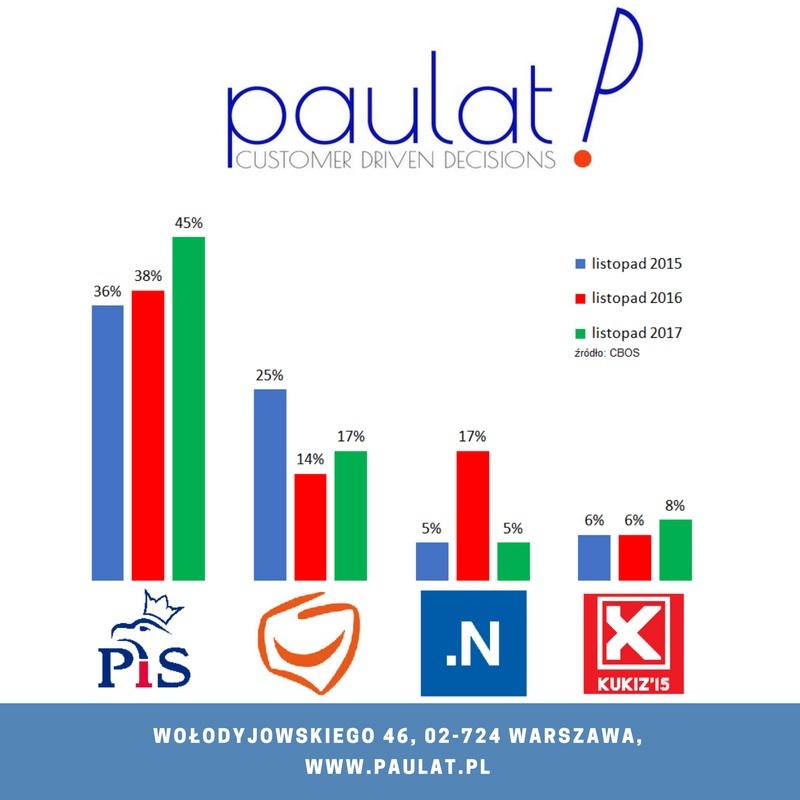Political polls are most often used to determine current political preferences.
They allow determining the level of support for a politician, a political group or for individual ideas, reforms, draft laws or political ideas.
The probe is not a poll.The survey is conducted on a representative sample of voters.The probe is a quiz on an unrepresentative sample of the probe recipients (e.g. social media followers).
Who are the polls for?
Polls are extremely useful for politicians, electoral staffs, parties and groups. Polls help in the selection of candidates, campaign topics, channels and methods of political communication. They also serve to run the campaign.
Polls are for you if you want to:
- Verify the direction of the campaign, the capacity of claims and postulates.
- Find out in which electoral districts the candidate has the biggest support
- Segment election areas for the purpose of the optimal promotion
- Determine the ideal and actual image of the candidate to strengten the most important/ winning attributes.
- Estimate the potential size of various electorates of voters- e.g. positive, neutral and negative electorates.
- Find out which topics are particularly relevant or engaging for voters in a given district to identify topics of political marketing during the campaign.
- Generate ideas, ideas, insights for political marketing - get content to build an engaging relationship with voters.
- Determine the needs, expectations, attitudes, behavior of voters
- Determine the voter segments, find out what profile voters support the candidate, party, ideas and political ideas.
- Find out which electorate is the most undecided, what part of the voters are considering voting for a given candidate / party.
- Get to know touchpoints with groups of voters and find out where and how to communicate with them precisely.
How are the polls carried out?
Surveys are a form of quantitative research carried out on large samples. Thanks to that it is possible to precisely forecast, model, quantify data, achieve high statistical significance and low error estimation. A standardized questionnaire is used to carry out the surveys.
The surveys are conducted using various techniques - the best (most close to the results of various choices). Popular techniques used in surveys are online surveys (CAWI), telephone interviews (CATI) or hybrid techniques - combining eg neuromarketing and online interviews.
The results of polls
The primary effect of the surveys are measurable, quantifiable, statistically significant rankings, rating scales, levels of support, and political preferences. The results of the surveys (and the recommendations coming from them) are based on quantifiable, measurable, comparable data and correlations - dependencies between features.
The results of the surveys are used to shape the electoral strategy as well as the current running of election campaigns. The results of the surveys are used as political arguments, commented and verified publicly - that is why the reliability of the results is the most important.
High representativeness (which is most often expressed using statistical indicators - low level of estimation error with a high level of confidence for the sample) and cyclical nature of the surveys allows us to capture real changes in the political landscape.
Examples of surveys
The results of the surveys allow to determine the current strength of the party, groups, and politicians. Most often, they are carried out in specific electoral districts among the electorate.
Since the beginning of 2015, we have conducted several dozen election polls - both nationwide and regional. In some of the largest agglomerations in Poland, we conduct cyclical studies of political moods.
10,000 interviews
3 repeatable, cyclical polls in Poland
14 street surveys, 12 telephone surveys, 28 online surveys
In addition, we carried out 18 studies of the political image, effectiveness tests of political campaigns and neuromarketing tests (defining unconscious reactions of sight and facial expressions).
We are characterized by the speed of action, effectiveness and adaptability of recommendations and modern research tools allowing us to achieve our competitive advantage and achieve the political goal - to win the elections.
